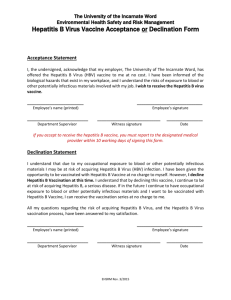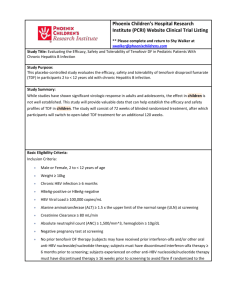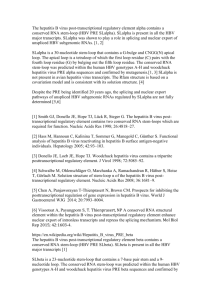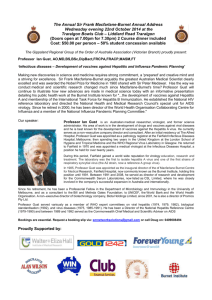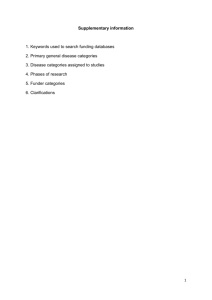HEP_26079_sm_SuppInfo
advertisement
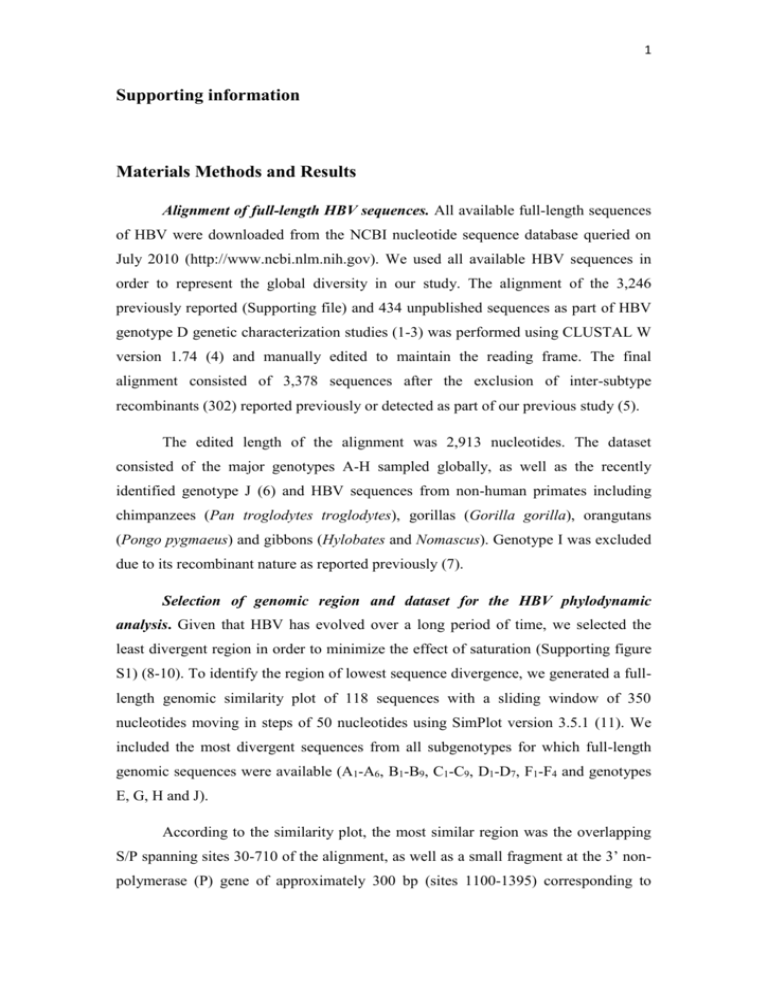
1 Supporting information Materials Methods and Results Alignment of full-length HBV sequences. All available full-length sequences of HBV were downloaded from the NCBI nucleotide sequence database queried on July 2010 (http://www.ncbi.nlm.nih.gov). We used all available HBV sequences in order to represent the global diversity in our study. The alignment of the 3,246 previously reported (Supporting file) and 434 unpublished sequences as part of HBV genotype D genetic characterization studies (1-3) was performed using CLUSTAL W version 1.74 (4) and manually edited to maintain the reading frame. The final alignment consisted of 3,378 sequences after the exclusion of inter-subtype recombinants (302) reported previously or detected as part of our previous study (5). The edited length of the alignment was 2,913 nucleotides. The dataset consisted of the major genotypes A-H sampled globally, as well as the recently identified genotype J (6) and HBV sequences from non-human primates including chimpanzees (Pan troglodytes troglodytes), gorillas (Gorilla gorilla), orangutans (Pongo pygmaeus) and gibbons (Hylobates and Nomascus). Genotype I was excluded due to its recombinant nature as reported previously (7). Selection of genomic region and dataset for the HBV phylodynamic analysis. Given that HBV has evolved over a long period of time, we selected the least divergent region in order to minimize the effect of saturation (Supporting figure S1) (8-10). To identify the region of lowest sequence divergence, we generated a fulllength genomic similarity plot of 118 sequences with a sliding window of 350 nucleotides moving in steps of 50 nucleotides using SimPlot version 3.5.1 (11). We included the most divergent sequences from all subgenotypes for which full-length genomic sequences were available (A1-A6, B1-B9, C1-C9, D1-D7, F1-F4 and genotypes E, G, H and J). According to the similarity plot, the most similar region was the overlapping S/P spanning sites 30-710 of the alignment, as well as a small fragment at the 3’ nonpolymerase (P) gene of approximately 300 bp (sites 1100-1395) corresponding to 2 positions 157-845 and 1162-1458 of the reference X02496 (genotype D) strain (12). Accordingly, we selected the overlapping S/P coding region (681 nt in length) as having the highest genetic similarity between all HBV genotypes. Moreover, as described previously (13), given the discordant clustering between “non-recombinant” HBV genotypes across the genome, this region (except for the genotypes A and G) shows the least discordance between genotypes. This renders it appropriate for studying the long-term evolution of HBV. Finally, the S gene is one of the cold spots for inter-subtype recombination (13-15). For the phylodynamic study, we selected at least 2 sequences from each of the HBV subgenotypes (A-D and F) and genotypes (E and G), respectively, while the only available full-length sequence of the recently identified genotype J was included in the analysis. Sequences were selected from the following subgenotypes: A1-A6, B1B9, C1-C9, D1-D7 and F1-F4. To ensure that the basal divergence in each clade was represented in our dataset, sequences were selected according to the branching order in the full-length genomic phylogenetic tree. Specifically, we selected the most distal sequences within the subgenotypes, as well as a set of sequences across the subgenotype clades. In addition to the sequences selected according to the criteria above, we performed a manual search in the nucleotide sequence database for partial sequences from the S/P region, isolated from indigenous populations from various parts of the world. Specifically, we focused on HBV sequences available at least in the S/P region, sampled from Pacific Oceania. The initial peopling of these areas occurred during known time periods, thus suggesting that they can be used as control calibration points for the dating of HBV lineages in these populations. The HBV sequences included in the analysis were from Indonesia, Near Oceania (New Guinea, Solomon Islands, Bismarck Archipelago), Remote Oceania (Vanuatu, Fiji, New Caledonia, New Zealand, Samoa, Tonga, Hawaii), Micronesia (Kiribati), Indonesia and Madagascar, as well as from the ancient African population the Bantus (16-21). Phylogenetic analyses and test for recombination. Phylogenetic trees were inferred by Neighbor-Joining (NJ) using maximum-likelihood distances under the general time-reversible (GTR) model of nucleotide substitution, with Γ-distributed rates among sites, as implemented in PAUP*4.0b10 (22). Visualization of the 3 estimated trees was performed using MEGA (version 4.0) (23) and FigTree (version 1.3.1) (http://tree.bio.ed.ac.uk/software/figtree/). All partial sequences included in the phylodynamic analysis were individually examined for any evidence of recombination by bootscanning analysis, using a sliding window of 350 bp moving in steps of 50 nt as implemented in Simplot. Recombination analysis was performed on all full-length sequences. Putative recombinant sequences showing evidence for discordant phylogenetic clustering within the S/P overlapping region were excluded from the analysis. Phylodynamic analyses Bayesian molecular clock analyses. The nucleotide substitution rate and the parameters of the demographic model were co-estimated using a Bayesian phylogenetic method as implemented in BEAST version 1.5.1(24). We used the GTR model of nucleotide substitution, assuming Γ-distributed rates among sites and a proportion of invariant sites. To accommodate rate heterogeneity among lineages, branch-specific rates were assumed to follow a lognormal distribution (an uncorrelated lognormal relaxed clock) (25). To model the population history, we used a Bayesian skyline plot (BSP) with 10 groups of intervals, where intervals are separated by coalescent events (24). Posterior distributions of parameters were obtained by Markov chain Monte Carlo (MCMC) analysis, which was run for 30106 steps in most cases, with a burnin of 3106 steps. MCMC chains were sampled every 1,000 steps. The program Tracer v1.4 (http://tree.bio.ed.ac.uk/software/tracer/) was used to check for convergence and to determine whether sufficient mixing of the Markov chain sampler had been achieved in the posterior target distribution (effective sample size>100). The maximum-clade-credibility tree for each analysis was identified using the program TreeAnnotator (24). Hypothesis testing for a recent HBV origin. The time to the most recent ancestor (tMRCA) of HBV lineages was recently inferred to be less than ~1,500 years for human sequences (26). This estimate was based on an analysis of 108 HBV sequences sampled across 21 years (1983-2004), calibrated using the known sampling 4 times. Several studies have indicated that the ability of sequence ages to provide sufficient calibrating information depends on the structure and spread of sampling times (27, 28). More recent analyses that use viral “fossils” (i.e. viral elements that have been preserved in animal genomes through germline inheritance) have shown that molecular clock analyses in old viral phylogenies using synchronous isolation dates results into severe underestimation of time to Most Recent Common Ancestor (tMRCA) dates (29). This phenomenon was revealed due to the plethora of animal genomes that provided us with specific viral “fossils”, but could not have been taken into account in previous analyses. Given that the sampling times of HBV only span two decades, it is expected that they would not be appropriate for calibrating the evolutionary timescale of HBV, which might span 40 ka. To investigate further and more specifically this expectation, we simulated 10 datasets constrained on the topology reported previously (26) (same number of sequences, genotype distribution, monophyly of each clade and sampling dates within the period of 1983-2004). However, the age of the root was rescaled so that it was drawn from a normal distribution with a mean of 40 ka. The simulated evolutionary rate was 2.2x10-6 substitutions/site/year, as estimated here (see below). The selection of 40 ka for the age of the root was based on the comparison of the total tree length with the length of the coalescence for genotypes F/H which, according to the global HBV phylogeography, corresponds to the settlement of the Americas ~15 ka ago (30). Therefore, if the hypothesis that HBV has been co-diverging with humans is indeed correct, our approach investigates whether evolutionary changes occurring over a short period of time (~20 years) are sufficient for calibrating an analysis of an old phylogeny. Phylogenies were simulated in BEAST (version 1.5.1) (24), while sequence alignments were generated using Seq-Gen version 1.3.2 (31). The simulated alignments were analyzed in BEAST (24) using the sampling times as calibrations, following the study by Zhou et al (26) and showed that the tMRCA is severely underestimated. Our simulations suggest, as has been empirically shown for other viruses (29), that molecular clock analysis of HBV needs to be performed using deeper calibration points; this view is currently widely accepted (29). The only endogenous viral element related to HBV has been found in inverterbates (sbhse) indicating a slow evolution of Hepadna viruses as expected under the human-HBV co-divergence 5 hypothesis (32). However, these viral elements are much more divergent than HBV and cannot be used to calibrate the molecular clock of within HBV genetic diversity. We should note however that at the time previous molecular clock analyses (26, 3335) were conducted the requirement of deep calibration points had not been explored. Only recently it became apparent that modern sequences are not sufficient to estimate old coalescent events (29). Phylogeographic estimations. To trace the origin of HBV infection for the different genotypes, we reconstructed the ancestral states of the tips (geographic areas) over the phylogenetic trees inferred using BEAST. Specifically, all the nodes of the inferred trees were assigned a character according to the geographic origin (e.g. 0, 1, 2, 3 for Near, Remote Oceania, S.E. Asia, Africa). The algorithm reconstructs “ancestral” states, which in our case correspond to geographic areas, at each internal node by the criterion of parsimony (36) as implemented in Mesquite program (37). Parsimony selects the reconstruction that minimizes the total number of steps on the tree (38). 6 References 1. Cox LE, Arslan O, Allain JP. Characterization of hepatitis B virus in Turkish blood donors, and the prevalence of the SP1 splice variant. Journal of medical virology 2011;83:1321-1325. 2. Garmiri P, Rezvan H, Abolghasemi H, Allain JP. Full genome characterization of hepatitis B virus strains from blood donors in Iran. Journal of medical virology 2011;83:948952. 3. Mahgoub S, Candotti D, El Ekiaby M, Allain JP. Hepatitis B virus (HBV) infection and recombination between HBV genotypes D and E in asymptomatic blood donors from Khartoum, Sudan. Journal of clinical microbiology 2011;49:298-306. 4. Thompson JD, Higgins DG, Gibson TJ. CLUSTAL W: improving the sensitivity of progressive multiple sequence alignment through sequence weighting, position-specific gap penalties and weight matrix choice. Nucleic Acids Res 1994;22:4673-4680. 5. Magiorkinis EN, Magiorkinis GN, Paraskevis DN, Hatzakis AE. Re-analysis of a human hepatitis B virus (HBV) isolate from an East African wild born Pan troglodytes schweinfurthii: evidence for interspecies recombination between HBV infecting chimpanzee and human. Gene 2005;349:165-171. 6. Tatematsu K, Tanaka Y, Kurbanov F, Sugauchi F, Mano S, Maeshiro T, Nakayoshi T, et al. A genetic variant of hepatitis B virus divergent from known human and ape genotypes isolated from a Japanese patient and provisionally assigned to new genotype J. J Virol 2009;83:10538-10547. 7. Kurbanov F, Tanaka Y, Kramvis A, Simmonds P, Mizokami M. When should "I" consider a new hepatitis B virus genotype? J Virol 2008;82:8241-8242. 8. Ho SY, Phillips MJ, Cooper A, Drummond AJ. Time dependency of molecular rate estimates and systematic overestimation of recent divergence times. Mol Biol Evol 2005;22:1561-1568. 9. Ho SY. An examination of phylogenetic models of substitution rate variation among lineages. Biol Lett 2009;5:421-424. 10. Endicott P, Ho SY, Metspalu M, Stringer C. Evaluating the mitochondrial timescale of human evolution. Trends Ecol Evol 2009;24:515-521. 11. Lole KS, Bollinger RC, Paranjape RS, Gadkari D, Kulkarni SS, Novak NG, Ingersoll R, et al. Full-length human immunodeficiency virus type 1 genomes from subtype C-infected seroconverters in India, with evidence of intersubtype recombination. J Virol 1999;73:152160. 12. Hawkes RA, Boughton CR, Ferguson V, Vale TG. The seroepidemiology of hepatitis in Papua New Guinea. II. A long-term study of hepatitis B. American journal of epidemiology 1981;114:563-573. 13. Simmonds P, Midgley S. Recombination in the genesis and evolution of hepatitis B virus genotypes. J Virol 2005;79:15467-15476. 14. Yang J, Xing K, Deng R, Wang J, Wang X. Identification of Hepatitis B virus putative intergenotype recombinants by using fragment typing. J Gen Virol 2006;87:2203-2215. 15. Morozov V, Pisareva M, Groudinin M. Homologous recombination between different genotypes of hepatitis B virus. Gene 2000;260:55-65. 16. Boisier P, Rabarijaona L, Piollet M, Roux JF, Zeller HG. Hepatitis B virus infection in general population in Madagascar: evidence for different epidemiological patterns in urban and in rural areas. Epidemiol Infect 1996;117:133-137. 7 17. Jazayeri MS, Basuni AA, Cooksley G, Locarnini S, Carman WF. Hepatitis B virus genotypes, core gene variability and ethnicity in the Pacific region. J Hepatol 2004;41:139146. 18. Lusida MI, Nugrahaputra VE, Soetjipto, Handajani R, Nagano-Fujii M, Sasayama M, Utsumi T, et al. Novel subgenotypes of hepatitis B virus genotypes C and D in Papua, Indonesia. J Clin Microbiol 2008;46:2160-2166. 19. Mulyanto, Depamede SN, Surayah K, Tjahyono AA, Jirintai, Nagashima S, Takahashi M, et al. Identification and characterization of novel hepatitis B virus subgenotype C10 in Nusa Tenggara, Indonesia. Arch Virol 2010;155:705-715. 20. Utsumi T, Lusida MI, Yano Y, Nugrahaputra VE, Amin M, Juniastuti, Soetjipto, et al. Complete genome sequence and phylogenetic relatedness of hepatitis B virus isolates in Papua, Indonesia. J Clin Microbiol 2009;47:1842-1847. 21. Kurbanov F, Tanaka Y, Fujiwara K, Sugauchi F, Mbanya D, Zekeng L, Ndembi N, et al. A new subtype (subgenotype) Ac (A3) of hepatitis B virus and recombination between genotypes A and E in Cameroon. J Gen Virol 2005;86:2047-2056. 22. Swofford DL. PAUP*. Phylogenetic Analysis Using Parsimony (*and Other Methods). Version 4. . Massachusetts, Sunderland: Sinauer Associates, 2000. 23. Tamura K, Dudley J, Nei M, Kumar S. MEGA4: Molecular Evolutionary Genetics Analysis (MEGA) software version 4.0. Mol Biol Evol 2007;24:1596-1599. 24. Drummond AJ, Rambaut A. BEAST: Bayesian evolutionary analysis by sampling trees. BMC Evol Biol 2007;7:214. 25. Drummond AJ, Ho SY, Phillips MJ, Rambaut A. Relaxed phylogenetics and dating with confidence. PLoS Biol 2006;4:e88. 26. Zhou Y, Holmes EC. Bayesian estimates of the evolutionary rate and age of hepatitis B virus. J Mol Evol 2007;65:197-205. 27. Firth C, Kitchen A, Shapiro B, Suchard MA, Holmes EC, Rambaut A. Using timestructured data to estimate evolutionary rates of double-stranded DNA viruses. Mol Biol Evol 2010;27:2038-2051. 28. Ho SY, Lanfear R, Phillips MJ, Barnes I, Thomas JA, Kolokotronis SO, Shapiro B. Bayesian estimation of substitution rates from ancient DNA sequences with low information content. Systematic biology 2011;60:366-375. 29. Worobey M, Telfer P, Souquiere S, Hunter M, Coleman CA, Metzger MJ, Reed P, et al. Island biogeography reveals the deep history of SIV. Science 2010;329:1487. 30. Goebel T, Waters MR, O'Rourke DH. The late Pleistocene dispersal of modern humans in the Americas. Science 2008;319:1497-1502. 31. Rambaut A, Grassly NC. Seq-Gen: an application for the Monte Carlo simulation of DNA sequence evolution along phylogenetic trees. Comput Appl Biosci 1997;13:235-238. 32. Holmes EC. The evolution of endogenous viral elements. Cell host & microbe 2011;10:368-377. 33. Hannoun C, Horal P, Lindh M. Long-term mutation rates in the hepatitis B virus genome. J Gen Virol 2000;81:75-83. 34. Okamoto H, Imai M, Kametani M, Nakamura T, Mayumi M. Genomic heterogeneity of hepatitis B virus in a 54-year-old woman who contracted the infection through maternofetal transmission. Jpn J Exp Med 1987;57:231-236. 35. Orito E, Mizokami M, Ina Y, Moriyama EN, Kameshima N, Yamamoto M, Gojobori T. Host-independent evolution and a genetic classification of the hepadnavirus family based on nucleotide sequences. Proc Natl Acad Sci U S A 1989;86:7059-7062. 36. Slatkin M, Maddison WP. A cladistic measure of gene flow inferred from the phylogenies of alleles. Genetics 1989;123:603-613. 37. Maddison WPaM, D.R. Mesquite: a modular system for evolutionary analysis. In. 2.6 ed; 2009. 8 38. Fitch WM. Toward defining the course of evolution: Minimal change for a specific tree topology. Systematic Zoology 1971:406-416. 39. Patterson F, Bumak J, Batey R. Changing prevalence of hepatitis B virus in urbanized Australian aborigines. J Gastroenterol Hepatol 1993;8:410-413. 40. Brindle RJ, Eglin RP, Parsons AJ, Hill AV, Selkon JB. HTLV-1, HIV-1, hepatitis B and hepatitis delta in the Pacific and South-East Asia: a serological survey. Epidemiol Infect 1988;100:153-156. 41. Gust ID, Dimitrakakis M, Bott F, Zimmet P. Studies on hepatitis B surface antigen and antibody in Nauru. II. Distribution amongst Gilbert and Ellice (Tuvalu) islanders. Am J Trop Med Hyg 1978;27:1206-1209. 42. Gust ID, Dimitrakakis M, Zimmet P. Studies on hepatitis B surface antigen and antibody in Nauru. I. Distribution amongst Nauruans. Am J Trop Med Hyg 1978;27:10301036. 43. Furusyo N, Hayashi J, Kakuda K, Sawayama Y, Ariyama I, Eddie R, Kashiwagi S. Markedly high seroprevalence of hepatitis B virus infection in comparison to hepatitis C virus and human T lymphotropic virus type-1 infections in selected Solomon Islands populations. Am J Trop Med Hyg 1999;61:85-91. 44. Tsai NC, Holck PS, Wong LL, Ricalde AA. Seroepidemiology of hepatitis B virus infection: analysis of mass screening in Hawaii. Hepatol Int 2008;2:478-485. 45. Sung JL. Hepatitis B virus eradication strategy for Asia. The Asian Regional Study Group. Vaccine 1990;8 Suppl:S95-99. 46. Sastrosoewignjo RI, Sandjaja B, Okamoto H. Molecular epidemiology of hepatitis B virus in Indonesia. J Gastroenterol Hepatol 1991;6:491-498. 47. Budihusodo U, Sulaiman HA, Akbar HN, Lesmana LA, Waspodo AS, Noer HM, Akahane Y, et al. Seroepidemiology of HBV and HCV infection in Jakarta, Indonesia. Gastroenterologia Japonica 1991;26 Suppl 3:196-201. 48. Braga WS, Brasil LM, de Souza RA, Castilho Mda C, da Fonseca JC. [The occurrence of hepatitis B and delta virus infection within seven Amerindian ethnic groups in the Brazilian western Amazon]. Rev Soc Bras Med Trop 2001;34:349-355. 49. Arboleda M, Castilho MC, Fonseca JC, Albuquerque BC, Saboia RC, Yoshida CF. Epidemiological aspects of hepatitis B and D virus infection in the northern region of Amazonas, Brazil. Trans R Soc Trop Med Hyg 1995;89:481-483. 50. Monsalve-Castillo F, Echevarria JM, Atencio R, Suarez A, Estevez J, Costa-Leon L, Montiel P, et al. [High prevalence of hepatitis B infection in Amerindians in Japreira, Zulia State, Venezuela]. Cad Saude Publica 2008;24:1183-1186. 51. Duarte MC, Cardona N, Poblete F, Gonzalez K, Garcia M, Pacheco M, Botto C, et al. A comparative epidemiological study of hepatitis B and hepatitis D virus infections in Yanomami and Piaroa Amerindians of Amazonas State, Venezuela. Trop Med Int Health 2010;15:924-933. 52. Leon P, Venegas E, Bengoechea L, Rojas E, Lopez JA, Elola C, Echevarria JM. [Prevalence of infections by hepatitis B, C, D and E viruses in Bolivia]. Rev Panam Salud Publica 1999;5:144-151. 53. Cabezas C, Suárez M, Romero GC, Carrillo CP, García MP, Reátegui JS, al e. Hiperendemicidad de hepatitis viral B Delta en pueblos indígenas de la Amazonia peruana. Rev Peru Med Exp Salud Pública 2006;23:114-122. 54. Nunes HM, Monteiro MR, Soares Mdo C. [Prevalence of hepatitis B and D serological markers in the Parakana, Apyterewa Indian Reservation, Para State, Brazil]. Cad Saude Publica 2007;23:2756-2766. 55. Larke RP, Froese GJ, Devine RD, Petruk MW. Extension of the epidemiology of hepatitis B in circumpolar regions through a comprehensive serologic study in the Northwest Territories of Canada. J Med Virol 1987;22:269-276. 9 56. Minuk GY, Ling N, Postl B, Waggoner JG, Nicolle LE, Hoofnagle JH. The changing epidemiology of hepatitis B virus infection in the Canadian north. Am J Epidemiol 1985;121:598-604. 57. Newey W, K. West, Kenneth, D. A Simple, Positive Semi-definite, Heteroskedasticity and Autocorrelation Consistent Covariance Matrix. Econometrica 1987; 55:703-708. 58. Baikie M, Ratnam S, Bryant DG, Jong M, Bokhout M. Epidemiologic features of hepatitis B virus infection in northern Labrador. CMAJ 1989;141:791-795. 59. Olsen OR, Skinhoj P, Krogsgaard K, Baek L. [Hepatitis B--an endemic sexually transmitted infection in a local community in Greenland]. Ugeskr Laeger 1989;151:16681670. 60. Langer BC, Frosner GG, von Brunn A. Epidemiological study of viral hepatitis types A, B, C, D and E among Inuits in West Greenland. J Viral Hepat 1997;4:339-349. 61. Skinhoj P. Hepatitis and hepatitis B-antigen in Greenland. II: Occurrence and interrelation of hepatitis B associated surface, core, and "e" antigen-antibody systems in a highly endemic area. Am J Epidemiol 1977;105:99-106. 62. Skinhoj P, McNair NA, Anderson ST. Hepatitis and hepatitis B-antigen in Greenland. Am J Epidemiol 1974;99:50-57. 63. Schreeder MT, Bender TR, McMahon BJ, Moser MR, Murphy BL, Sheller MJ, Heyward WL, et al. Prevalence of hepatitis B in selected Alaskan Eskimo villages. Am J Epidemiol 1983;118:543-549. 64. Manuĭlov VA, Netesova IG, Osipova LP, Shustov AV, Baiandin RB, Kochneva GV, Netesov SV. [Genetic variability of hepatitis B virus isolates among population of Shuryskarsky area of Yamal-Nenets autonomous region]. Mol Gen Mikrobiol Virusol. 2005;4:30-34. 65. Netesova IG, Swenson PD OL, Kiselev NN, Posukh OL, Cherepanova NS, Kazakovtseva MA, KashinskaiaIuO, Netesov SV. [Hepatitis B markers in southern Altaĭ inhabitants of the village of Mendur-Sokkon (the Republic of Altaĭ). . . [HBsAg subtyping in hepatitis B virus isolates with monoclonal antibodies]. Zh Mikrobiol Epidemiol Immunobiol 2001;2:29-33. 66. Reshetnikov OV, Khryanin AA, Teinina TR, Krivenchuk NA, Zimina IY. Hepatitis B and C seroprevalence in Novosibirsk, western Siberia. Sex Transm Infect 2001;77:463. 67. Ohba K, Mizokami M, Kato T, Ueda R, Gurtsenvitch V, Senyuta N, Syrtsev A, et al. Seroprevalence of hepatitis B virus, hepatitis C virus and GB virus-C infections in Siberia. Epidemiol Infect 1999;122:139-143. 10 Figure legends Supporting figure 1 Similarity plot of full-length genomic HBV genotype A against genotypes B-J, using a sliding window of 350 nts moving in steps of 50 nts. Positions in the alignment are shown on the horizontal axis. The data set comprises 118 sequences and includes different HBV subgenotypes sampled globally. Supporting figure 2 Dated HBV phylogeny showing subgenotypes within genotype A. HBV isolates are coloured according to their geographic origin; similarly, nodes are coloured according to their origin as inferred by phylogeographic analysis. All nodes with posterior probabilities higher than 0.85 are denoted by stars. Numbers on the horizontal axis correspond to years before present. Supporting figure 3 Dated HBV phylogeny showing subgenotypes within genotype B. Supporting figure 4 Dated HBV phylogeny showing subgenotypes within genotypes F and H. 11 Supporting Table 1 Prevalence of HBV infection (HBsAg) among indigenous populations Geographic area Prevalence Study Australia 17.0% (39) Papua-New Guinea 15.0% (12, 40) Palau 3.0% (40) Guam 4.0% (40) Truk 7.0% (40) Ponape 2.0% (40) Majuro 16.0% (40) Nauru 16.0% (40) Solomon Islands 20-30% (41-43) Kiribati 32.0% (40) Vanuatu 40.0% (40) Tuvalu 7.0% (40) Tahiti 2.0% (40) Hawaii 3.6% (44) New Zealand (Maori) 10.0-12.0% (45) Indonesia 2.1-10.5% (46, 47) Taiwan 15.0% (45) Brazil (Amazon Basin) 0-21% (48, 49) Venezuela 5-30% (50, 51) Near Oceania Remote Oceania Eastern Asia South America 12 Bolivia 9.5% (52) Peru 9.4% (53) Brazil (Parakana) 1.1-5.4% (54) Canada 3.0% (55) Canada (Nunavut) 4% (56, 57) Labrador 3.2% (58) Greenland 7.0-16.6 (59-62) Alaska 6.0% (63) Siberia (Yamal-Nenets) 3.0% (64) Siberia (Altaian village) 13.0% (65) Siberia (Novosibirsk) 1.1-3.5% (66) Siberia (Kamchatka) 12.0% (67) Arctic

